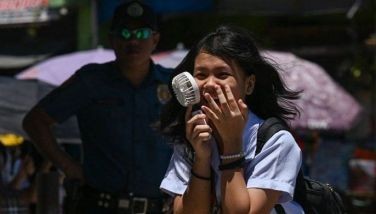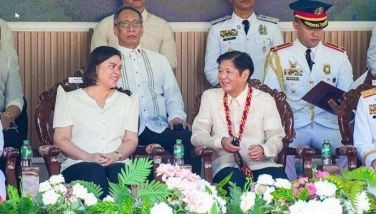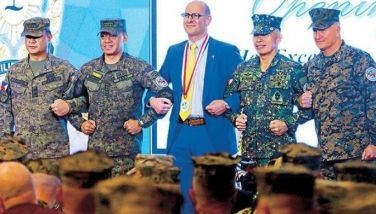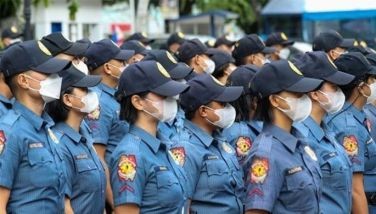Search for Yamashita treasure continues
August 13, 2005 | 12:00am
LOS BAÑOS, Laguna (AFP) — Rumors of secret maps, symbols carved in rocks and booby-trapped underground chambers filled with looted gold have lured treasure hunters to the Philippines for decades.
They are drawn by a legend that Japanese occupying forces stashed away billions of dollars’ worth of bullion and precious artifacts looted from across Asia when they realized their empire was collapsing in 1945.
In a tale filled with rumors of cover-ups and conspiracy, treasure hunters claim that US forces spirited away much of the horde after the war and that billions of dollars’ worth of loot remain unaccounted for.
For many, though, the Yamashita treasure, named after the wartime military governor of the archipelago, General Tomoyuki Yamashita, is nothing more than a fable with no evidence to back up the booty hunters’ outlandish claims.
Today, armed with a pruning hook, Nicanor Brun guards the general’s memorial stone from weeds and tomb raiders. The shrine lies on the lower slopes of a mountain, surrounded by an orchard beside a mountain brook.
Brun says his late mother told him Yamashita was strung up from a branch of an old mango tree at the site on the lower slopes of Mount Makiling in Laguna in early 1946.
"There are a lot of diggings around," says the 47-year-old grandson of an anti-Japanese resistance fighter.
He says there have been several excavations in the area, including at the base of a waterfall called Dampalit where residents say treasure hunters recovered stones with Japanese characters inscribed on them.
According to legend, after defeating British forces in Malaya and Singapore, where he earned himself the moniker the "Tiger of Malaya," Yamashita looted 12 countries in East and South-East Asia and shipped the booty to the Philippines.
Six decades after the Japanese surrender, Internet chatrooms are alive with tales of networks of tunnels and chambers filled with gold and protected by booby-traps, pressure mines and trip wires laid by Japanese engineers.
"One of our companions died in a poison trap, fortunately he was able to bring home two bars of gold," writes one treasure hunter.
"We know the site but our problem is how to get our hands on the treasure without getting poisoned. The site is within a poisoned waterfall."
Others write of buying up plots of land in areas where Japanese troops were stationed or made their last stand against US troops. They say the sites are dotted with markings such as hearts, arrows and pyramids carved into rocks.
One describes "three big rocks one meter below the ground with a mark on top, a hand-painted square with a dot at its center, the number six and a key."
"My friends found a huge arrow pointing to the river. The river floor was checked and they discovered a man-made tunnel," writes another.
"What they discovered was a big seven-foot-high engraved heart shape with a curved tail on the tunnel wall. In the middle of the engraved heart was a deep hole large enough for the whole arm to insert in.
"Do you think it is a Japanese treasure site?"
Another rumor claims that the same sappers who designed the warrens deep underground were buried alive with the treasure by their commanders setting off explosive charges to ensure that the locations be kept secret.
An even darker side of the story has it that the stashes were cursed by the Japanese and dotted with decapitated heads, while tales abound of treasure hunters dying or disappearing in mysterious circumstances.
By and large, however, experts give little credence to the stories.
"Despite all the treasure hunters, their maps, oral testimony and sophisticated metal detectors, nobody has found a thing," says Ambeth Ocampo, chairman of the National Historical Institute.
Since the existence of the treasure has never been proven, theories of what it likely contains range from lines of gold bullion piled meters high, of solid gold Buddha statues weighing more than a ton, of loose diamonds, gold coins and priceless artifacts looted from temples.
One account claims the existence of gems, rare art, such as ancient Chinese scrolls and precious metals, all plundered from Asian treasuries, banks, private homes, art galleries and pawn shops owned by Chinese tycoons, Malay royalty, Buddhist sects, drug lords and triad gangs.
Unlike art looted by the Nazis in Europe, none of the Yamashita "treasures" has been found, regional governments insist.
"We have heard of people searching for the so-called Yamashita treasure. But we cannot tell if it is true or not," a Japanese foreign ministry spokeswoman said in Tokyo. Other countries are similarly circumspect.
But failure has not deterred the dreamers, who have bored underneath historical sites, Japanese cemeteries, wartime-era military fortifications, government buildings, churches, and even private lots for half a century — with or without government permits.
Authors Sterling and Peggy Seagrave in their 2003 book "Gold Warriors: America’s Secret Recovery of Yamashita’s Gold" allege the US government covertly recovered the booty and used it to bankroll the Cold War.
No Filipino historian takes the claims seriously.
Feeding the rumors are further rumors, of secret maps, of snippets of information given by Japanese soldiers as they went to their deaths.
One theorist alleges that Yamashita’s driver was tortured by US agents into revealing treasure sites.
Another suggests that General Douglas Macarthur, who commanded US forces in East Asia and went on to accept Japan’s surrender, ordered Yamashita’s trial and execution to keep him quiet.
"It’s become something like an urban legend-type story," said University of the Philippines professor Rico Jose, a local authority on the Japanese period here.
Some of the hunters, foreign and Filipino, have approached him for help in deciphering maps and manuscripts that supposedly detail the treasure sites.
The booty was supposed to have been shipped into the Philippines late in the war after Yamashita became governor of the islands. Japan occupied the Philippines in May 1942 adding it to its expanding empire.
But Jose said that by 1943 "the Japanese were no longer in control of the seas" around the Philippines as US submarine warfare wiped out Japanese convoys.
"It doesn’t make sense to bring in something that valuable here when you know it’s going to be lost to the Americans anyway," he says.
"The more rational thing would have been to send it to Taiwan or China," Taiwan being a Japanese colony at the time with still secure sea lanes between the island and Thailand and Burma.
"There are big-scale diggings and there are some small-scale diggings. People just have a hunch that this place holds the treasure," Jose said.
A peasant woman from Mindoro showed up at historian Jose’s Manila office six years ago, carrying a cracked and weathered military helmet that she insisted was owned by a Japanese soldier and covered with a map drawing of a treasure hoard.
"I told her, ‘I’m sorry but that’s an American helmet, and that is natural weathering,’" Jose said. "She was very disappointed because she comes from a poor family."
In August 2003 tomb raiders went through a Japanese cemetery in the Davao City, host to a large Japanese immigrant community before the war. More than 67 tombs were desecrated.
The hunts sometimes lead to disaster.
One Filipino treasure hunter was killed and four colleagues were injured in an underground tunnel in a private lot on the central island of Mactan three years ago.
More than a decade earlier, former US Green Beret captain Charles McDougal brought a large team to excavate parts of Manila’s Fort Santiago, a Japanese-era prison, as well as nearby Corregidor island, where US and Filipino forces had made their last stand against the Japanese invasion in 1942.
Two team members were killed in a cave-in, and McDougal abandoned the hunt, apparently without success.
Historian Jose says even the late dictator Ferdinand Marcos — a member of the anti-Japanese guerrilla resistance — got in on the act in the 1970s, ordering a team of divers into the wreck of the Japanese World War II-era cruiser Na Chi resting at the bottom of Manila Bay.
Marcos’ widow Imelda later claimed her husband had found the Yamashita treasure, while the estate of Roger Roxas, the Philippines’ most famous treasure hunter who died in 1993, filed a lawsuit claiming Marcos removed the gold from the Philippines with the help of the US government.
Roxas said he found a three-foot solid gold Buddha statue and a hoard of gold bars in a network of underground tunnels beneath a government hospital in Baguio City in 1971.
"When treasure hunters think about tunnels, they think there’s always treasure there," says Jose.
"But there were thousands of tunnels that the Japanese built as part of their defense network. If you dig up some of these tunnels, you’d find bullets, bones of the Japanese dead, actually."
Jose says Tokyo’s silence about the issue may have contributed to the treasure myth.
After paying war reparations, Tokyo sent salvage crews to the Philippines in the 1950s to retrieve cargo, including copper and strategic raw materials from their sunken vessels.
"The official rationale for this was, they were blocking rivers, blocking Manila Bay... as part of clearing operations," Jose says. "This was suspicious in hindsight because they knew what was in those vessels."
Jose dismisses many of the diggers as criminal racketeers. By the 1970s and 1980s, he says, a number of treasure hunters began soliciting funds from US veterans to finance digs that were nothing but scams.
Regardless, the myth endures and the searches continue.
Sixty years on and one forlorn treasure hunter writes on a web forum: "We had various Japanese treasure maps on hand but cannot decipher a single word.
"Mr. Yamato, can you help us?"
They are drawn by a legend that Japanese occupying forces stashed away billions of dollars’ worth of bullion and precious artifacts looted from across Asia when they realized their empire was collapsing in 1945.
In a tale filled with rumors of cover-ups and conspiracy, treasure hunters claim that US forces spirited away much of the horde after the war and that billions of dollars’ worth of loot remain unaccounted for.
For many, though, the Yamashita treasure, named after the wartime military governor of the archipelago, General Tomoyuki Yamashita, is nothing more than a fable with no evidence to back up the booty hunters’ outlandish claims.
Today, armed with a pruning hook, Nicanor Brun guards the general’s memorial stone from weeds and tomb raiders. The shrine lies on the lower slopes of a mountain, surrounded by an orchard beside a mountain brook.
Brun says his late mother told him Yamashita was strung up from a branch of an old mango tree at the site on the lower slopes of Mount Makiling in Laguna in early 1946.
"There are a lot of diggings around," says the 47-year-old grandson of an anti-Japanese resistance fighter.
He says there have been several excavations in the area, including at the base of a waterfall called Dampalit where residents say treasure hunters recovered stones with Japanese characters inscribed on them.
According to legend, after defeating British forces in Malaya and Singapore, where he earned himself the moniker the "Tiger of Malaya," Yamashita looted 12 countries in East and South-East Asia and shipped the booty to the Philippines.
Six decades after the Japanese surrender, Internet chatrooms are alive with tales of networks of tunnels and chambers filled with gold and protected by booby-traps, pressure mines and trip wires laid by Japanese engineers.
"One of our companions died in a poison trap, fortunately he was able to bring home two bars of gold," writes one treasure hunter.
"We know the site but our problem is how to get our hands on the treasure without getting poisoned. The site is within a poisoned waterfall."
Others write of buying up plots of land in areas where Japanese troops were stationed or made their last stand against US troops. They say the sites are dotted with markings such as hearts, arrows and pyramids carved into rocks.
One describes "three big rocks one meter below the ground with a mark on top, a hand-painted square with a dot at its center, the number six and a key."
"My friends found a huge arrow pointing to the river. The river floor was checked and they discovered a man-made tunnel," writes another.
"What they discovered was a big seven-foot-high engraved heart shape with a curved tail on the tunnel wall. In the middle of the engraved heart was a deep hole large enough for the whole arm to insert in.
"Do you think it is a Japanese treasure site?"
Another rumor claims that the same sappers who designed the warrens deep underground were buried alive with the treasure by their commanders setting off explosive charges to ensure that the locations be kept secret.
An even darker side of the story has it that the stashes were cursed by the Japanese and dotted with decapitated heads, while tales abound of treasure hunters dying or disappearing in mysterious circumstances.
"Despite all the treasure hunters, their maps, oral testimony and sophisticated metal detectors, nobody has found a thing," says Ambeth Ocampo, chairman of the National Historical Institute.
Since the existence of the treasure has never been proven, theories of what it likely contains range from lines of gold bullion piled meters high, of solid gold Buddha statues weighing more than a ton, of loose diamonds, gold coins and priceless artifacts looted from temples.
One account claims the existence of gems, rare art, such as ancient Chinese scrolls and precious metals, all plundered from Asian treasuries, banks, private homes, art galleries and pawn shops owned by Chinese tycoons, Malay royalty, Buddhist sects, drug lords and triad gangs.
Unlike art looted by the Nazis in Europe, none of the Yamashita "treasures" has been found, regional governments insist.
"We have heard of people searching for the so-called Yamashita treasure. But we cannot tell if it is true or not," a Japanese foreign ministry spokeswoman said in Tokyo. Other countries are similarly circumspect.
But failure has not deterred the dreamers, who have bored underneath historical sites, Japanese cemeteries, wartime-era military fortifications, government buildings, churches, and even private lots for half a century — with or without government permits.
Authors Sterling and Peggy Seagrave in their 2003 book "Gold Warriors: America’s Secret Recovery of Yamashita’s Gold" allege the US government covertly recovered the booty and used it to bankroll the Cold War.
No Filipino historian takes the claims seriously.
Feeding the rumors are further rumors, of secret maps, of snippets of information given by Japanese soldiers as they went to their deaths.
One theorist alleges that Yamashita’s driver was tortured by US agents into revealing treasure sites.
Another suggests that General Douglas Macarthur, who commanded US forces in East Asia and went on to accept Japan’s surrender, ordered Yamashita’s trial and execution to keep him quiet.
"It’s become something like an urban legend-type story," said University of the Philippines professor Rico Jose, a local authority on the Japanese period here.
Some of the hunters, foreign and Filipino, have approached him for help in deciphering maps and manuscripts that supposedly detail the treasure sites.
The booty was supposed to have been shipped into the Philippines late in the war after Yamashita became governor of the islands. Japan occupied the Philippines in May 1942 adding it to its expanding empire.
But Jose said that by 1943 "the Japanese were no longer in control of the seas" around the Philippines as US submarine warfare wiped out Japanese convoys.
"It doesn’t make sense to bring in something that valuable here when you know it’s going to be lost to the Americans anyway," he says.
"The more rational thing would have been to send it to Taiwan or China," Taiwan being a Japanese colony at the time with still secure sea lanes between the island and Thailand and Burma.
"There are big-scale diggings and there are some small-scale diggings. People just have a hunch that this place holds the treasure," Jose said.
"I told her, ‘I’m sorry but that’s an American helmet, and that is natural weathering,’" Jose said. "She was very disappointed because she comes from a poor family."
In August 2003 tomb raiders went through a Japanese cemetery in the Davao City, host to a large Japanese immigrant community before the war. More than 67 tombs were desecrated.
The hunts sometimes lead to disaster.
One Filipino treasure hunter was killed and four colleagues were injured in an underground tunnel in a private lot on the central island of Mactan three years ago.
More than a decade earlier, former US Green Beret captain Charles McDougal brought a large team to excavate parts of Manila’s Fort Santiago, a Japanese-era prison, as well as nearby Corregidor island, where US and Filipino forces had made their last stand against the Japanese invasion in 1942.
Two team members were killed in a cave-in, and McDougal abandoned the hunt, apparently without success.
Historian Jose says even the late dictator Ferdinand Marcos — a member of the anti-Japanese guerrilla resistance — got in on the act in the 1970s, ordering a team of divers into the wreck of the Japanese World War II-era cruiser Na Chi resting at the bottom of Manila Bay.
Marcos’ widow Imelda later claimed her husband had found the Yamashita treasure, while the estate of Roger Roxas, the Philippines’ most famous treasure hunter who died in 1993, filed a lawsuit claiming Marcos removed the gold from the Philippines with the help of the US government.
Roxas said he found a three-foot solid gold Buddha statue and a hoard of gold bars in a network of underground tunnels beneath a government hospital in Baguio City in 1971.
"When treasure hunters think about tunnels, they think there’s always treasure there," says Jose.
"But there were thousands of tunnels that the Japanese built as part of their defense network. If you dig up some of these tunnels, you’d find bullets, bones of the Japanese dead, actually."
Jose says Tokyo’s silence about the issue may have contributed to the treasure myth.
After paying war reparations, Tokyo sent salvage crews to the Philippines in the 1950s to retrieve cargo, including copper and strategic raw materials from their sunken vessels.
"The official rationale for this was, they were blocking rivers, blocking Manila Bay... as part of clearing operations," Jose says. "This was suspicious in hindsight because they knew what was in those vessels."
Jose dismisses many of the diggers as criminal racketeers. By the 1970s and 1980s, he says, a number of treasure hunters began soliciting funds from US veterans to finance digs that were nothing but scams.
Regardless, the myth endures and the searches continue.
Sixty years on and one forlorn treasure hunter writes on a web forum: "We had various Japanese treasure maps on hand but cannot decipher a single word.
"Mr. Yamato, can you help us?"
BrandSpace Articles
<
>
- Latest
- Trending
Trending
Latest
Trending
Latest
Recommended



























